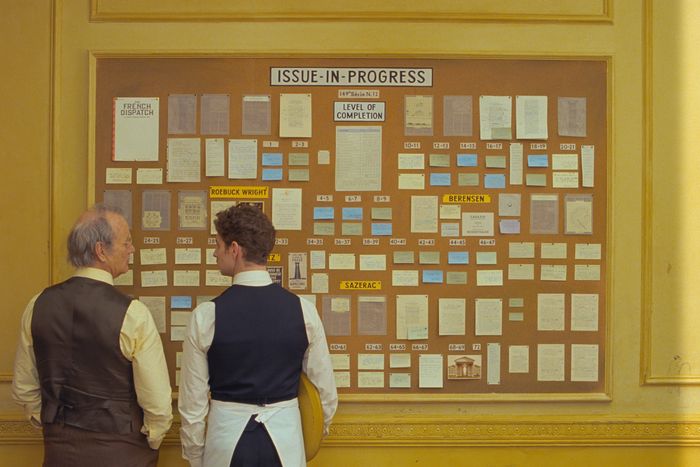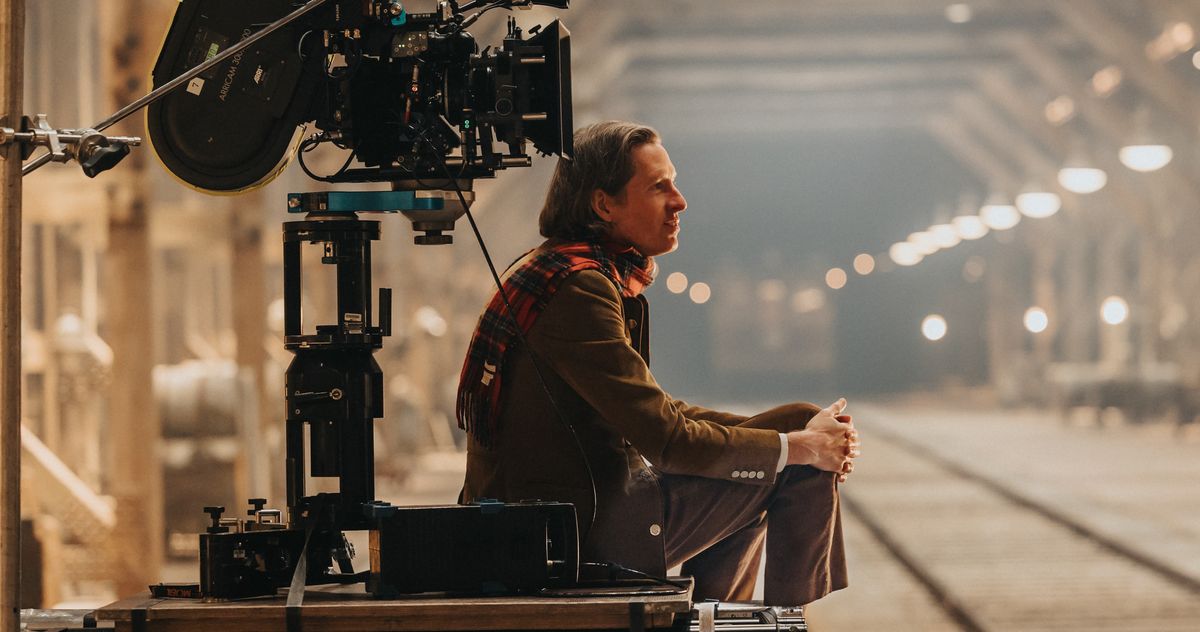Wes Anderson’s new film, The Phoenician Scheme, stars Benicio del Toro as the tyrannical tycoon Zsa-Zsa Korda, who grapples with his mortality during surreal, dream-like sequences, including a black-and-white funeral for a boy. While the film combines humor with themes of existential dread, it reflects contemporary issues like economic manipulation and authoritarianism, echoing real-world events, including recent political changes. Anderson, inspired by personal experiences and historical figures, presents Zsa-Zsa as a morally ambiguous character navigating a chaotic landscape. The film showcases the evolving nature of Anderson’s storytelling, balancing meticulous craftsmanship with a deeper exploration of life’s complexities.
Photo: Roger Do Minh/TPS Productions/Focus Features
“I believe the boy was killed by those who were supposed to love him.”
Wes Anderson discusses a surreal sequence in his new film, The Phoenician Scheme, where the main character, the merciless global magnate Zsa-Zsa Korda (Benicio del Toro), is confronted with a vision of the afterlife. After narrowly escaping death, he attends a monochrome heavenly funeral for a young boy in a coffin. Who is this boy? Does Zsa-Zsa recognize him, or is it a reflection of himself? In this dream-like state, Zsa-Zsa spots his late grandmother next to him. “Why are we here?” he inquires. She does not recognize him. Suddenly, the boy awakens — and so does Zsa-Zsa.
The Phoenician Scheme, set to debut at this year’s Cannes Film Festival, may be a comedy — likely Anderson’s funniest in a while — yet it also embodies the unique blend of whimsy and existential angst that he has honed over the past decade. Zsa-Zsa’s afterlife visions extend beyond the funeral; throughout the film, he finds himself embroiled in various celestial panels. Drawing inspiration from Surrealist filmmaker Luis Buñuel infused with a touch of Michael Powell’s dreaminess, these black-and-white sequences vary widely in tone: actors (including Bill Murray and F. Murray Abraham) don exaggerated prosthetics and makeup. “These moments reflect Zsa-Zsa’s internal experience — a neurological journey,” Anderson notes. “He’s being confronted with his mortality in such a forceful way that it’s reshaping his worldview, something he’s never embraced before. The lessons he learns in these instances stem from within himself.”
Benicio del Toro portrays Zsa-Zsa, whose intense expression can shift from cold determination to complete confusion, making him a compelling character. It’s notable that Anderson’s vision for The Phoenician Scheme originated from his wish to feature this specific actor as the lead. During the 2021 Cannes premiere of The French Dispatch, Anderson approached del Toro about casting him as a European tycoon reminiscent of characters from 1960s Italian cinema. This character later evolved, notably influenced by Anderson’s late father-in-law, Fuad Malouf, a Lebanese engineer with numerous international endeavors. “As he started showing signs of dementia, he wanted my wife to understand his world,” Anderson recalls. “He revealed a closet filled with shoe boxes, outlining projects in Saudi Arabia and Gibraltar, detailing his connections.” A scene echoes this as Zsa-Zsa, after surviving an assassination attempt, lays out boxes to explain his various ventures to his novice daughter, Liesl (Mia Threapleton), hoping she will manage them one day.
Malouf had an intimidating presence, but Anderson insists they had a strong rapport. The darker aspects of Zsa-Zsa’s persona — his avarice, deceit, vindictiveness, paranoia, neglect of family, and casual disregard for the suffering of others — were inspired by several notorious 20th-century business figures: the infamous shipping tycoon Aristotle Onassis, producer Carlo Ponti, banker Árpád Plesch, and Armenian fixer Calouste Gulbenkian, the notorious middleman dubbed “Mr. Five Percent,” known for enabling Western exploitation of oil-rich regions in the Middle East.
Michael Cera, Benicio del Toro, and Mia Threapleton in The Phoenician Scheme.
Photo: TPS Productions/Focus Features
In The Phoenician Scheme, the often unlikable yet deadpan-funny Zsa-Zsa finds himself faced with financial challenges when the cost of a crucial bolt skyrockets. This forces him to travel from country to country, renegotiating contracts with his associates, coercing them into absorbing the increased expenses of his numerous construction ventures. Essentially, it’s a narrative about trade conflicts and economic manipulation, anchored by a harsh absent father and a cynical megalomaniac who revels in making disastrous deals. (This might also be the first Wes Anderson film where the audience has to crunch some numbers.) If the film and its lead resonate with certain unsettling aspects of today’s reality — all wrapped in a uniquely ‘Wes Anderson’ style — it’s no coincidence. “Often, while creating a film, if I’m referencing a historical event, two weeks into filming, I’ll be struck by how it’s actually playing out in the present,” he states. Our conversation coincided with Donald Trump’s declaration of a 100 percent tariff on foreign films. “I can’t even begin to ponder the implications,” Anderson chuckles bitterly. “What does that mean? You’ll just take all the profits?”
Despite Zsa-Zsa’s Trump-like attributes, Anderson doesn’t view him as a stand-in for the former president. “Donald Trump lacks any moral compass, while I believe Zsa-Zsa possesses one,” he asserts. “Zsa-Zsa does have principles, yet he chooses to ignore them, allowing for the possibility of self-discovery throughout the tale.”
Though known for creating polished and whimsical films (thankfully, we’re past calling them twee), it’s hard to overlook the darkness that has seeped into his seemingly sugar-coated worlds. Grand Budapest Hotel (2014) evolves from a lighthearted escapade featuring a clever concierge in a fictional Central European locale to a narrative about imminent fascism, border closures, arbitrary arrests, and civil decay. Meanwhile, the animated critique Isle of Dogs (2018) unfolds in an imaginary Japanese city dominated by a corrupt dictator who has banished all dogs to a deserted isle. One might argue that while Wes Anderson exists in a universe of his own, he began tackling themes of rising authoritarianism long before many other allegedly more socially conscious creators. As his style has become increasingly elaborate, the topics he explores seem ever more relevant to current affairs.
However, this evolution wasn’t driven by a desire for relevance but rather reflects his broadened horizons. “Growing up in a small environment until I was 20, my worldview was quite limited,” Anderson, who hails from Houston, explains. “At some point, I opted to expand my perspective beyond my upbringing.” Relocating to Paris in the mid-2000s marked a significant turning point, as did starting a family. One of the joys of witnessing Anderson’s cinematic journey is observing his growth alongside his work, transitioning from lighthearted coming-of-age tales in his early career — where the older characters’ brushes with mortality felt like innocent contemplations from a youthful dreamer — to more introspective works steeped in regret and embracing life’s inherent mysteries. “By the time we reached Asteroid City, those themes were deeply embedded in the narrative,” he reflects on his 2023 film, which contemplates the confounding nature of both the universe and human emotions. “The essence of mystery drives that film — the enigma of death and the pursuit of artistic expression.”
Asteroid City builds upon the intricate narrative structure of The French Dispatch, a compilation of stories about journalists. Throughout these various arcs, characters yearn to transcend their realities, often without clarity on how to achieve it: an incarcerated artist in love, French students rebelling against a predetermined fate, and a gay African American writer (partially inspired by James Baldwin) living in self-imposed exile in France, channeling his emotions into well-crafted food articles. The recurring line—“Make it sound like you intended it that way,” offered by a controlling magazine editor to his writers—might also serve as a reflection of Anderson himself. In his films, a shroud of intention conceals underlying despair, and the façade of artifice hides the uncertainties beneath.
Interestingly, as Anderson grows in wisdom and reflection, his films have taken on a meme-worthy precision and detail. His directorial choices are fine-tuned, with compositions resembling a blend of vintage Belgian comic books and award-winning high-school science projects. Questions have arisen about whether he will ever revert to a more naturalistic style. However, he has not faltered. “That’s not necessarily my choice,” he chuckles. “Whatever I create tends to reflect my essence. When it’s filtered through my perspective, it inevitably assumes this form. If you were beside me and suggested a different camera angle, I might respond, ‘I understand … but I prefer it here.’”


From left: The French Dispatch. Photo: Searchlight Pictures/Everett CollectionAsteroid City. Photo: Focus Features/Everett Collection
From top: The French Dispatch. Photo: Searchlight Pictures/Everett CollectionAsteroid City. Photo: Focus Features/Everett Collection
However, in line with the visuals, his narratives have also become kaleidoscopically intricate. Asteroid City assumes various formats — it’s part film, part 1950s television drama, part play, and part radio broadcast. A narrator reminds us that nothing we’re witnessing is real; it’s a fabrication: “Asteroid City is non-existent,” the narrator states. “This is an imaginary tale crafted specifically for this presentation. The characters are fictitious, the dialogue conjectural, and the scenarios apocryphal.” Meanwhile, The French Dispatch is framed as a collection of articles from the final issue of a fictional magazine, each tale spinning into its own tapestry of flashbacks, memories, projections, and nested narratives, delightfully shifting between color, black-and-white, and varying aspect ratios. These complexities escalate to nearly obsessive levels, which eventually imbue viewers, along with the characters, with a profound sense of disorientation. “It’s a quality I appreciate in cinema,” Anderson notes. “As narratives become more abstract, I find them deeply moving. This has become a preferred space for me compared to earlier in my career.”
This disorientation is pivotal for the films’ impact. As I expressed in my review of Asteroid City: “Anderson’s meticulously crafted dioramas delve into our innate human need to organize and manage our existence amidst unpredictability.” Much akin to Anderson himself, his characters obsess over minutiae and strive to control their realities. Yet this precision achieves the contrary: the chaotic intertwining of tales results in overwhelming ambiguity, leaving the characters increasingly adrift. When I begin to share this thought with Anderson, he interjects with a grin: “Perhaps that’s why they seem so controlled,” he remarks.
Surprisingly, there was a time when Wes Anderson identified with the principles of filmmakers like John Cassavetes — valuing spontaneity and improvisation. During the production of his debut feature, Bottle Rocket, he experimented with creating unscripted moments. “I was inspired by how William Friedkin could introduce unexpected chaos on set, leading to authentic, spontaneous reactions,” he recounts. For a particular scene, he instructed an actress to surprise Owen Wilson with a banana daiquiri. “When it happened, Owen just halted, bewildered and upset, and asked, ‘Why’d you do that?’ She replied, ‘Wes told me to,’” Anderson reminisces. “What I aimed to capture as a spontaneous moment was thwarted entirely. Owen felt genuinely betrayed.” Perhaps the concept was sound, but it didn’t suit Anderson’s style. “I ended up trailing Owen for a considerable distance, attempting to soothe him while wardrobe personnel informed me, ‘We don’t have a spare shirt for Owen.’”
Thus, the improvisational style of Cassavetes and Friedkin faded, yet the essence of spontaneity remains embedded in his increasingly polished creations. “For The Darjeeling Limited, we devised a structured shooting plan: we organized as much as possible, yet we remained open to serendipitous moments during filming,” Anderson shares, reflecting on his 2007 production shot in India. “There were instances where events diverged sharply from our expectations, and we embraced those changes.” Were the results successful? Critics had mixed reviews upon release — yet over time, Darjeeling Limited has earned a more favorable reassessment.
Anderson attributes his refined control over cinematography to the process of creating his animated feature, The Fantastic Mr. Fox (2009). Since then, he has utilized animatics extensively to plan his scenes. “We liken it to a cartoon storyboard of the sequences,” he elaborates. Initially intended for his production designer Adam Stockhausen and cinematographer, he notes that over time, actors expressed interest in viewing them as well. “Willem Dafoe was the first to encourage others: ‘Check this out! This is what Wes envisions for you.’” Conversely, some actors chose to avoid it entirely: “Ralph Fiennes has no interest in seeing the cartoon.”
So, what role does uncertainty play for him now? In an environment defined by meticulousness, does Anderson still welcome unpredictability? He highlights his actors: “When collaborating with talents like Benicio, Timothée Chalamet, or Benedict Cumberbatch,” he explains, “these are performers who challenge you to capture authentic moments. They might lead you in unexpected directions, allowing you to explore new possibilities. Benicio has a monumental presence, and you often find yourself pondering which facet of it you’re about to witness.”
This brings us back to the deceased boy and Zsa-Zsa’s visions alongside his celestial tribunals, introducing an element of dream-like logic and psychological complexity to The Phoenician Scheme’s intricate narrative. While we attempt to categorize these ephemeral moments, they remain elusive and fleeting. Rich with symbols and notions, they resist complete understanding — ultimately serving as a glimpse into a mind in disarray. “Zsa-Zsa embodies a control freak stripped of authority,” Anderson posits. “His neurons are firing in unconventional ways, and the most profound transformations occur when he closes his eyes.” In essence, he epitomizes a quintessential Wes Anderson character: a figure whose yearning to impose order leads to existential upheaval and unending introspection.

